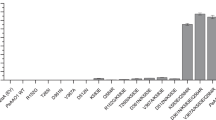Abstract
A 1,965-bp fragment encoding a poly(vinyl alcohol) dehydrogenase (PVADH) from Sphingopyxis sp. 113P3 was synthesized based on the codon bias of the methylotrophic yeast Pichia pastoris. The fragment was then amplified by polymerase chain reaction and inserted into the site between EcoRI and NotI sites in pPIC9K, which was under the control of the AOX1 promoter and α-mating factor signal sequence from Saccharomyces cerevisiae. The recombinant plasmid, designated as pPIC9K-PVADH, was linearized using SalI and transformed into P. pastoris GS115 by electroporation. The PVADH activity reached 55 U/mL in a shake flask and 902 U/mL in a 3-L bioreactor. Surprisingly, the sodium dodecyl sulfate polyacrylamide gel electrophoresis analysis and N-terminal sequencing indicated that the secreted PVADH was truncated, and it had only 548 amino acid residues (an 81-amino acid sequence from the secreted protein was cleaved). The optimum pH and temperature ranges for the truncated PVADH were 7.0–8.0 and 41–53 °C, respectively. The activation energy of the recombinant truncated PVADH was approximately 10.36 kcal/mol between 29 and 41 °C. Both Ca2+ and Mg2+ had stimulating effects on the activity of PVADH. With PVA1799 as the substrate, the truncated PVADH had a Michaelis constant (K m) of 1.89 mg/mL and a maximum reaction rate (V max) of 34.9 nmol/(min mg protein). To the best of our knowledge, this is the first report on the expression of PVADH in P. pastoris, and the achieved PVADH yield is the highest ever reported.





Similar content being viewed by others
References
Brenner C, Fuller RS (1992) Structural and enzymatic characterization of a purified prohormone-processing enzyme: secreted, soluble Kex2 protease. Proc Natl Acad Sci U S A 89:922–926
Brunel L, Neugnot V, Landucci L, Boze WN, Moulin G, Bigey F (2004) High-level expression of Candida parapsilosis lipase/acyltransferase in Pichia pastoris. J Biotechnol 111:41–50
Daly R, Hearn MT (2005) Expression of heterologous proteins in Pichia pastoris: a useful experimental tool in protein engineering and production. J Mol Recognit 18:119–138
Hatanaka T, Asahi N, Tsuji M (1995a) Purification and characterization of poly(vinyl alcohol) dehydrogenase from Pseudomonas sp. 113P3. Biosci Biotechnol Biochem 59:1813–1816
Hatanaka T, Kawahara T, Asahi N, Tsuji M (1995b) Effects of the structure of poly(vinyl alcohol) on the dehydrogenation reaction by poly(vinyl alcohol) dehydrogenase from Pseudomonas sp. 113P3. Biosci Biotechnol Biochem 59:1229–1231
Hirota-Mamoto R, Nagai R, Tachibana S, YasudaM TA, Kimbara K, Kawai F (2006) Cloning and expression of the gene for periplasmic poly(vinyl alcohol) dehydrogenase from Sphingomonas sp. strain 113P3, a novel-type quinohaemoprotein alcohol dehydrogenase. Microbiology 152:1941–1949
Hu X, Mamoto R, Fujioka Y, Tani A, Kimbara K, Kawai F (2008) The pva operon is located on the megaplasmid of Sphingopyxis sp. strain 113P3 and is constitutively expressed, although expression is enhanced by PVA. Appl Microbiol Biotechnol 78:685–693
Kawai F, Hu X (2009) Biochemistry of microbial polyvinyl alcohol degradation. Appl Microbiol Biotechnol 84:227–237
Macauley-Patrick S, Fazenda ML, McNeil B, Harvey LM (2005) Heterologous protein production using the Pichia pastoris expression system. Yeast 22:249–270
Matsumura S, Tomizawa N, Toki A, Nishikawa K, Toshima K (1999) Novel poly(vinyl alcohol)-degrading enzyme and the degradation mechanism. Macromolecules 32:7753–7761
Micheelsen PO, Ostergaard PR, Lange L, Skjot M (2008) High-level expression of the native barley alpha-amylase/subtilisin inhibitor in Pichia pastoris. J Biotechnol 133(4):424–432
Raemaekers RJ, de Muro L, Gatehouse JA, Fordham-Skelton AP (1999) Functional phytohemagglutinin (PHA) and Galanthus nivalis agglutinin (GNA) expressed in Pichia pastoris correct N-terminal processing and secretion of heterologous proteins expressed using the PHA-E signal peptide. Eur J Biochem 265:394–403
Sakai K, Hamada N, Watanabe Y (1986) Degradation mechanism of poly(vinyl alcohol) by successive reactions of secondary alcohol oxidase and β-diketone hydrolase from Pseudomonas sp. Agric Biol Chem 50:989–996
Shimao M (2001) Biodegradation of plastics. Curr Opin Biotechnol 12:242–247
Shimao M, Tamogami T, Nishi K, Harayama S (1996) Cloning and characterization of the gene encoding pyrroloquinoline quinone dependent poly(vinyl alcohol) dehydrogenase of Pseudomonas sp. strain VM15C. Biosci Biotechnol Biochem 60:1056–1062
Shimao M, Tamogami T, Kishida S, Harayama S (2000) The gene pvaB encodes oxidized polyvinyl alcohol hydrolase of Pseudomonas sp. strain VM15C and forms an operon with the polyvinyl alcohol dehydrogenase gene pvaA. Microbiology 146:649–657
Sinclair G, Choy FY (2002) Synonymous codon usage bias and the expression of human glucocerebrosidase in the methylotrophic yeast, Pichia pastoris. Protein Expr Purif 26:96–105
Teng D, Fan Y, Yang YL, Tian ZG, Luo J, Wang JH (2007) Codon optimization of Bacillus licheniformis beta-1,3-1,4-glucanase gene and its expression in Pichia pastoris. Appl Microbiol Biotechnol 74(5):1074–1083
Toyama H, Mathews FS, Adachi O, Matsushita K (2004) Quinohemoprotein alcohol dehydrogenases: structure, function, and physiology. Arch Biochem Biophys 428:10–21
Tull D, Gottschalk TE, Svendsen I, Kramhøft B, Phillipson BA, Bisgård-Frantzen H, Olsen O, Svensson B (2001) Extensive N-glycosylation reduces the thermal stability of a recombinant alkalophilic bacillus alpha-amylase produced in Pichia pastoris. Protein Expr Purif 2:13–23
Werten MW, den Bosch TJv, Wind RD, Mooibroek H, de Wolf FA (1999) High-yield secretion of recombinant gelatins by Pichia pastoris. Yeast 15:1087–1096
Acknowledgments
This project was financially supported by the Priority Academic Program Development of Jiangsu Higher Education Institutions, the 111 Project (111-2-06), the National High Technology Research and Development Program of China (863 Program, 2011AA100905), the Priority Academic Program Development of Jiangsu Higher Education Institution, the PhD Research Fund of Jiangnan University, and the 973 Program (2012CB720802 and 2012CB720806).
Author information
Authors and Affiliations
Corresponding authors
Additional information
Jianghua Li equally contributed with the first author.
Electronic supplementary materials
Below is the link to the electronic supplementary material.
ESM 1
(DOCX 1873 kb)
Rights and permissions
About this article
Cite this article
Jia, D., Li, J., Liu, L. et al. High-level expression, purification, and enzymatic characterization of truncated poly(vinyl alcohol) dehydrogenase in methylotrophic yeast Pichia pastoris . Appl Microbiol Biotechnol 97, 1113–1120 (2013). https://doi.org/10.1007/s00253-012-3986-3
Received:
Revised:
Accepted:
Published:
Issue Date:
DOI: https://doi.org/10.1007/s00253-012-3986-3




